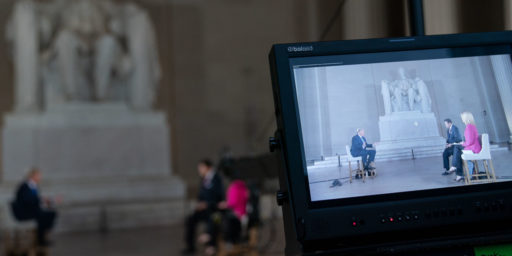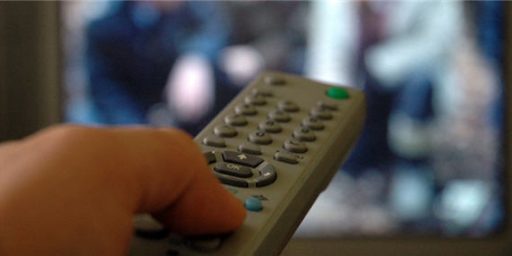The Deterioration and Death of Old Media
Headline News Network is shuttering after four decades.

Former CNN anchor Brian Stelter laments “The End of Companion Television.”
Media Winter is here once more, and it is getting ugly. It seems as though every news giant is shrinking toward 2023 through end-of-year layoffs, hiring freezes, or otherwise Dickensian austerity. Text chains and Slack channels are bursting with farewells and expressions of uncertainty about the future.
Industry veterans will tell you they’ve come to expect these Christmas-time cutbacks. The Gannett newspaper chain is laying off scores of local and national journalists. NPR is looking for ways to save at least $10 million. The Washington Post is ending its Sunday magazine. CNN, where I was an anchor until August, is cutting several hundred jobs.
As usual, explanations vary. The advertising marketplace is softening. Economic headwinds are worsening. Shareholder demands are unforgiving. But the effect is always the same: contraction, lost livelihoods, diminished brands, fewer outlets for both reporters and consumers.
Because of shifts in my own news consumption, I wouldn’t have noticed any of these changes without them being pointed out. And, yes, this technically means fewer choices for us as consumers but, frankly, there are so many out there that it barely matters. But, absolutely, this trend is terrible for those who make their living in the industry or hoped to do so in the future.
Yet there’s something different this time around. Job losses in journalism have been rolling across the industry for decades now. But it’s not every day that a fixture of cable television goes belly up. The demise of HLN, CNN’s 40-year-old sister station, which will stop airing original newscasts next week, deserves attention not just because it marks the end of an era but because it’s a reminder of how eras in media actually end. Before death comes obsolescence.
HLN, better known as Headline News, was a Ted Turner creation. The founding father of cable news rushed HLN to air on New Year’s Day 1982, a mere 19 months after he launched CNN. The goal was to preempt a rival with a similar idea: a headline-driven TV channel that would mimic the nonstop wheels of news radio. Whereas CNN in those days had a wide variety of programming, including in-depth interview shows, HLN had headlines around the clock. Quick bursts of news, barely 280 characters at a time, were perfectly suited for a pre-broadband age when news was relatively scarce.
Stelter is almost exactly 20 years younger than me and literally wasn’t born when HLN debuted. My parents got cable while I was in high school, circa 1982-83, and we frequently had it on the then-unabbreviated Headline News channel in the mornings. I haven’t watched it in decades but my impression of it in those early days was that it was essentially 48 consecutive nightly newscasts with slightly lower production value and considerably less charismatic anchors.
If you watched in succession, it became obvious that the changes in each half-hour episode were iterative. But the experience was transformative: you could get a full 30-minute newscast literally any 30-minute period you wanted it. If you tuned in at 6:43 in the morning, you could sit through the last 17 minutes of the episode and the first 13 minutes of the next and be caught up.
There was no Internet outside of limited government and higher education circles. Obviously, there was no Twitter. So it was truly remarkable not to have to wait until Dan Rather, Peter Jennings, or Tom Brokaw came on at 5:30 (we lived on Central Time most of my youth).
Just as YouTube destroyed the MTV we once knew, the informational environment created by iPhones and tweetstorms irrevocably changed HLN. But irrevocable change can be hard to see as it is happening. Perhaps counterintuitively, the reinvention of a broadcast medium plays out anticlimactically, like a slowly abandoned shopping mall—one store closes at a time until the whole structure serves a different purpose.
Again, unlike Stelter, I remember the heyday of MTV. Which, incidentally, was “destroyed” in its original form well before YouTube’s 2005 debut. As the channel’s Wiki notes, “From 1995 to 2000, MTV played 36.5% fewer music videos. MTV president Van Toffler stated: ‘Clearly, the novelty of just showing music videos has worn off. It’s required us to reinvent ourselves to a contemporary audience.'” Reality shows and the like increasingly replaced music as the channel’s focus.
At HLN, executives first tried to refashion the channel with new reasons to tune in, creating talk shows hosted by Glenn Beck, Joy Behar, Drew Pinsky, and others. The biggest hit was Nancy Grace’s fear-stoking crime fest. Grace pointed a profitable way forward for HLN, but the overall endeavor was a branding nightmare—crime one hour, comedy the next. The channel was revamped so many times that even Wikipedia could barely keep up. In retrospect, it’s clear that the network wasn’t simply pivoting, to use industry parlance. The ground was shifting dramatically, and HLN was trying to find a way to stay standing. Here’s the problem with obsolescence, though: It isn’t just the ground that shifts. It’s the whole media universe.
Indeed. And, frankly, less of this crap is a boon for mankind, not a loss.
Television news, the way I see it, is about consistency and companionship. Or it was, anyway. TV journalists break big stories and speak truth to power the same way journalists in every other medium do—but the thing that sets TV apart is the relationship forged between the people on either side of the screen. Viewers form emotional bonds with the anchors they watch and stream. This was certainly the case for devotees of HLN’s weekday-morning host, Robin Meade, who was one of the longest-tenured morning hosts in history, and who lost her job in the gutting of HLN.
Meade, a former Miss Ohio, debuted on the network in 2001, by which point I was getting most of my news online. I do remember original host Chuck Roberts pretty well, although I don’t know that I had a “relationship” with him. But that’s certainly the model of the three network news shows.
No one at HLN whom I’ve spoken with in the past 24 hours was completely surprised to be canceled. To a person, they chalked it up to management’s quest for billions of dollars in cost reductions. They had seen the news coverage get snipped and sheared for years, gradually replaced by titillating true-crime reruns. It seemed inevitable that the news on HLN would stop altogether at some point. But hosts like Meade still had a fan base that your average podcast host or Substack writer could only dream of. She also had an audience outside of her industry’s coastal bubbles—with fans in towns and cities all across America.
Yes, but I’m guessing that audience was geriatric—folks who got into the habit of watching television news decades ago and never got out of it. Aside from breaking news events of a highly visual nature (say, the Capitol Riots) there’s not much reason to turn to television for straight-up news reporting. Even the news networks’ websites are more useful and efficient than sitting through someone reading you news for 30 minutes, punctuated with breaks for advertising laxatives, adult diapers, and burial insurance.
That’s a pivotal part of this story. HLN exhibited a polite sensibility—lighter and less politically focused than Fox News, CNN, or MSNBC; Meade’s producers made time for entertainment and sports and lifestyle coverage. “How to carve your turkey” was a top segment before Thanksgiving. If you were home alone and wanted to leave on the TV all morning, you could do worse than HLN. Even in this age of pinpoint on-demand streaming, HLN asserted that companionship TV still had value.
I’m sure. But holy mother of god, how depressing is that?
But now? Effective next week, HLN will stop producing live news coverage. It will transform almost completely into a true-crime channel. (CNN will simulcast its recently rebooted morning show on HLN, but that’s primarily a concession to long-standing cable deals that say HLN must carry some amount of straight news.) In a flattened media world where practically anyone can read headlines or annotate a live-streamed trial, HLN seems to have been rendered obsolete. That’s why I am skeptical, too, of the TV start-ups that are trying to replicate the old Headline News wheel for less money and with less staff.
There, we’re in complete agreement.
There are lots of things to love about our endlessly fragmenting information environment, complicated though it is. But Meade’s fans are right to feel a sense of loss. This strained moment for TV news has no small number of anchors and hosts questioning what they thought they knew about the medium—and how much shelf space will exist for them in the future. Another channel is disappearing into the TV ether. Viewers tuning in for companionship may find only the faintest echo of what once was. The TV will still be on, but all the warmth is gone.
That’s sad for Meade and her fans. But companionship was always a byproduct of broadcast news. Viewers chose between Walter Cronkite, David Brinkley, and Harry Reasoner not based on their superior reporting chops but based on connection and habit. But, primarily, folks tuned in because it was the easiest way to keep up with the day’s events in that era. Newspapers and news magazines provided more depth but were less up-to-date and took more work.
We’re likely to see the end of the nightly network news broadcasts in my lifetime. Their audiences are literally dying off. I suspect the only reason they still exist—they’ve always been unprofitable—is FCC licensing requirements to provide some minimum amount of public interest programming. But there are other, less expensive, ways of doing that.






Ah, that still existed… reminds me of my first job out of uni, at a french news agency , we had that on all the time. This makes me wonder at the business model of Euronews which is a morning habit – albiet via IPTV for convenience (and not having ever bothered to set up a terrestrial antenna on getting a smart TV…). Although reading the wiki page gives one pause about models.
I used to watch that many years ago when I was traveling internationally. Very handy. Then it disappeared? Or maybe I just stopped turning on the TV in my hotel room once I didn’t need it as a source of news or the weather forecast.
I always thought of HLN as the video equivalent of USA Today — something that allowed people who don’t care about the news to feel as if they’re informed, when they’re really not. Zaslav is doing all sorts of terrible things to Warners to pay down a debt that only exists because he believes he’s such a supergenius he should be in charge no matter the cost… but this isn’t one of them.
@wr:
This is spot on. Also makes me think of variants:
Vox – for people who do care about the news to feel as if they’re informed, when they’re really not
TED Talks – for people who do (or want to) care about science to feel as if they’re informed, when they’re really not
Podcasts – [this one has too many possibilities]
(I’m being playfully ungenerous here…which doesn’t make it inaccurate)
OTB-For people who want to be informed and entertained and can be if they read entire posts, links and comments.
(I confess that I don’t always make it through everything.)
And video killed the radio star, too. The end of Headline News, however, may be at least a genuine example of the sort of “creative destruction” that Schumpeter was talking about as opposed to the usual examples of conglomeration/market capture and offshoring that usually try to pass for it.
On my road trips when I have access to TV I tune in CNN and HLN. Last time I saw listings for HLN, Sunday, Nov. 27, they were running a West Wing Marathon. Still haven’t seen any episodes of that show.